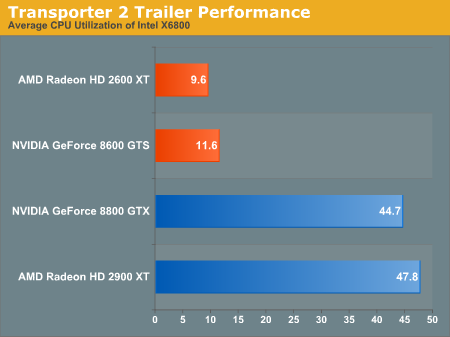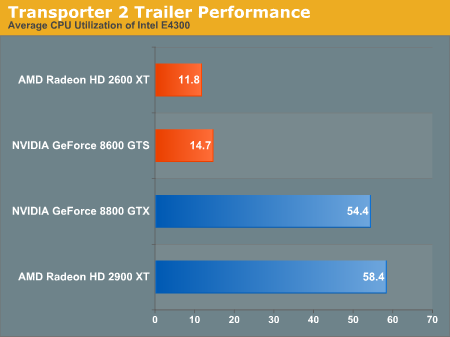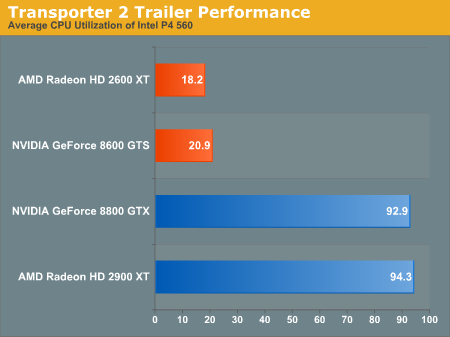HD Video Decode Quality and Performance Summer '07
by Derek Wilson on July 23, 2007 5:30 AM EST- Posted in
- GPUs
Transporter 2 Trailer (High Bitrate H.264) Performance
This is our heaviest hitting benchmark of the bunch. Nestled into the recesses of the Blu-ray version of The League of Extraordinary Gentlemen (a horrible move if ever there was one) is a very aggressively encoded trailer for Transporter 2. This ~2 minute trailer is encoded with an average bitrate of 40 Mbps. The bitrate actually peaks at nearly 54 Mbps by our observation. This pushes up to the limit of H.264 bitrates allowed on Blu-ray movies, and serves as an excellent test for a decoder's ability to handle the full range of H.264 encoded content we could see on Blu-ray discs.
First up is our high performance CPU test (X6800):

Neither the HD 2900 XT nor the 8800 GTX feature bitstream decoding on any level. They are fairly representative of older generation cards from AMD and NVIDIA (respectively) as we've seen in past articles. Clearly, a lack of bitstream decoding is not a problem for such a high end processor, and because end users generally pair high end processors with high end graphics cards, we shouldn't see any problems.
Lower CPU usage is always better. By using an AMD card with UVD, or an NVIDIA card featuring VP2 hardware (such as the 8600 GTS), we see a significant impact on CPU overhead. While AMD does a better job at offloading the CPU (indicating less driver overhead on the part of AMD), both of these solutions enable users to easily run CPU intensive background tasks while watching HD movies.
Next up is our look at an affordable current generation CPU (E4300):

While CPU usage goes up across the board, we still have plenty of power to handle HD decode even without H.264 bitstream decoding on our high end GPUs. The story is a little different when we look at older hardware, specifically our Pentium 4 560 (with Hyper-Threading) processor:

Remember that these are average CPU utilization figures. Neither the AMD nor the NVIDIA high end parts are able to handle decoding in conjunction with the old P4 part. Our NetBurst architecture hardware just does not have what it takes even with heavy assistance from the graphics subsystem and we often hit 100% CPU utilization without one of the GPUs that support bitstream decoding.
Of course, bitstream decoding delivers in a HUGE way here, not only making HD H.264 movies watchable on older CPUs, but even giving us quite a bit of headroom to play with. We wouldn't expect people to pair the high end hardware with these low end CPUs, so there isn't much of a problem with the lack in this area.
Clearly offloading CABAC and CAVLC bitstream processing for H.264 was the right move, as the hardware has a significant impact on the capabilities of the system on the whole. NVIDIA is counting on bitstream processing for VC-1 not really making a difference, and we'll take a look at that in a few pages. First up is another H.264 test case.
This is our heaviest hitting benchmark of the bunch. Nestled into the recesses of the Blu-ray version of The League of Extraordinary Gentlemen (a horrible move if ever there was one) is a very aggressively encoded trailer for Transporter 2. This ~2 minute trailer is encoded with an average bitrate of 40 Mbps. The bitrate actually peaks at nearly 54 Mbps by our observation. This pushes up to the limit of H.264 bitrates allowed on Blu-ray movies, and serves as an excellent test for a decoder's ability to handle the full range of H.264 encoded content we could see on Blu-ray discs.
First up is our high performance CPU test (X6800):

Neither the HD 2900 XT nor the 8800 GTX feature bitstream decoding on any level. They are fairly representative of older generation cards from AMD and NVIDIA (respectively) as we've seen in past articles. Clearly, a lack of bitstream decoding is not a problem for such a high end processor, and because end users generally pair high end processors with high end graphics cards, we shouldn't see any problems.
Lower CPU usage is always better. By using an AMD card with UVD, or an NVIDIA card featuring VP2 hardware (such as the 8600 GTS), we see a significant impact on CPU overhead. While AMD does a better job at offloading the CPU (indicating less driver overhead on the part of AMD), both of these solutions enable users to easily run CPU intensive background tasks while watching HD movies.
Next up is our look at an affordable current generation CPU (E4300):

While CPU usage goes up across the board, we still have plenty of power to handle HD decode even without H.264 bitstream decoding on our high end GPUs. The story is a little different when we look at older hardware, specifically our Pentium 4 560 (with Hyper-Threading) processor:

Remember that these are average CPU utilization figures. Neither the AMD nor the NVIDIA high end parts are able to handle decoding in conjunction with the old P4 part. Our NetBurst architecture hardware just does not have what it takes even with heavy assistance from the graphics subsystem and we often hit 100% CPU utilization without one of the GPUs that support bitstream decoding.
Of course, bitstream decoding delivers in a HUGE way here, not only making HD H.264 movies watchable on older CPUs, but even giving us quite a bit of headroom to play with. We wouldn't expect people to pair the high end hardware with these low end CPUs, so there isn't much of a problem with the lack in this area.
Clearly offloading CABAC and CAVLC bitstream processing for H.264 was the right move, as the hardware has a significant impact on the capabilities of the system on the whole. NVIDIA is counting on bitstream processing for VC-1 not really making a difference, and we'll take a look at that in a few pages. First up is another H.264 test case.










63 Comments
View All Comments
erwos - Monday, July 23, 2007 - link
Does it? Because I thought that was only for MPEG-2. Link?smitty3268 - Monday, July 23, 2007 - link
Most drivers only support it with MPEG-2, but that doesn't mean it isn't capable of more. Looking again, I'm a little unclear about how much work would be required to get it working. I'm not sure if it is completely done and just requires support from the hardware vendors or if it also needs some additional work before that happens.http://www.mythtv.org/wiki/index.php/XvMC">http://www.mythtv.org/wiki/index.php/XvMC
http://en.wikipedia.org/wiki/X-Video_Motion_Compen...">http://en.wikipedia.org/wiki/X-Video_Motion_Compen...
Per Hansson - Monday, July 23, 2007 - link
Hi, it would be really interesting to see similar tests done in Linux alsoFor example how cheap of a HTPC rig can you build, with free software too, and still provide betters features than any of the commercial solutions.
I think we are many that have some old hardware laying around. And when seeing this article it brings up ideas. Pairing the old computer with a (AGP?) ATI 2600 card would provide an ideal solution in a nice HTPC chassi under the TV perhaps?
jojo4u - Monday, July 23, 2007 - link
Linux is not practical. You would have to crack AACS and dump the disc first.Per Hansson - Monday, July 23, 2007 - link
Hmm, I did not realize thatHowever a HTPC can still be built to be a player for satellite data for example, granted configuring all that up with a subscription card will not be for the faint of heart. But then again the Dreambox 8000 is not available yet, only a new decoder from Kathrein UFS910 with no decent software (yet)
jojo4u - Monday, July 23, 2007 - link
Hi Derek,good review. However, based on a review of the german written magazine C't I have some suggestions and additions:
PowerDVD patch 2911, Catalyst 7.6, Nvidia 158.24
- the Geforce G84/85 miss not only VC-1 but also MPEG-2 bitstream processing.
- the HD 2400 does not have MPEG-2 bitstream processing, frequency transform and pixel prediction or it is not activated.
- A single core Athlon is significantly worse than a single core Pentium IV. The reson is AACS. Decryption puts a hudge load on the CPU and is optimized for Intel CPUs (9%->39% H.264, Pentium IV, Casino Royale). Perhaps later patches made the situation better (like your Yozakura shows?)
- VC-1 on the Radeons and Geforces showed picture distortions, but based on your review this seems to be fixed now
Combinations of Athlon 3500+, X2 6000+, Pentium IV 3,2 GHz, Pentium E2160 and HD 2400/2600, Geforce 8600 GTS which resulted in lagging in MPEG-2 or VC-1 or H.264
3500+ + 690G/2400/2600/8600
6000+ + 690G
Pentium IV + 8600
Chunga29 - Monday, July 23, 2007 - link
Why run with older drivers? If these features are important to you, you will need to stay on top of the driver game. Would have been interesting to see AMD chips in there, but then that would require a different motherboard as well. I think the use of a P4 560 was perfectly acceptable - it's a low-end CPU and if it can handle playback with the 2600/8600 then Athlons will be fine as well.8steve8 - Monday, July 23, 2007 - link
nice article..but, while i usually think anandtech conclusions are insightful and spot on,
it seems odd not to give props to the 2600xt which dominated the benchmarks.
for the occasional gamer who often likes watching videos, it seems the 2600xt is a great choice, better than the 8600gts.
for example for VC1, on a low end c2duo the difference between 7% and 19.2% matters, esp if the person likes watching a video while working or browsing or whatever...
can amd add noise reduction options later w/ a driver update?
defter - Tuesday, July 24, 2007 - link
How can that matter? Even in worst case you have 80% of idle CPU time.
Besides, how can you "work" while watching video at the same time? And don't try to tell me that a web browser takes over 80% of CPU time with Core2 Duo system...
drebo - Monday, July 23, 2007 - link
We all know why this is.
I'll give you a hint: look at the overwhelming presence of Intel advertising on this site.
It doesn't take a genius to figure it out. That's why I don't take the video and CPU reviews on this site seriously anymore.